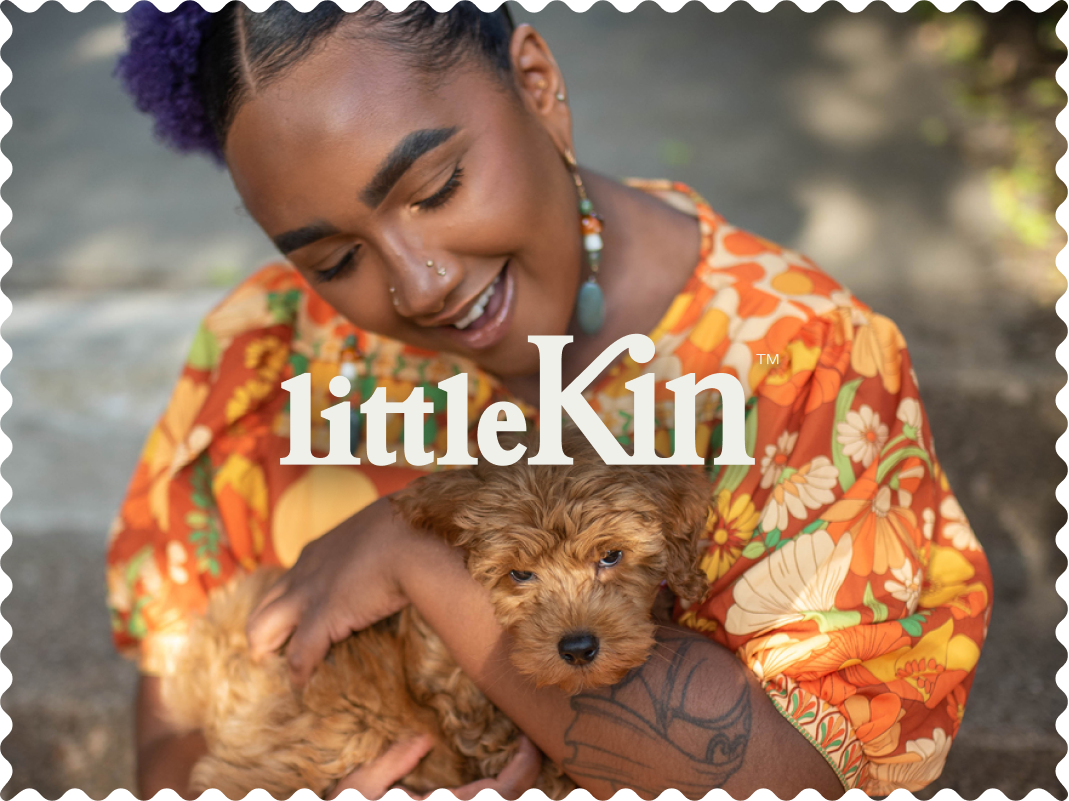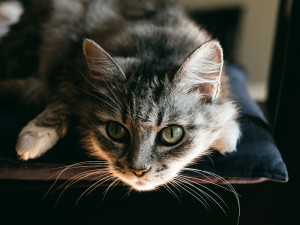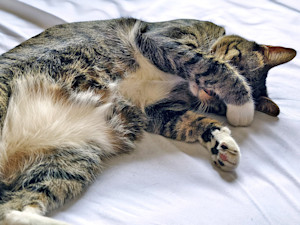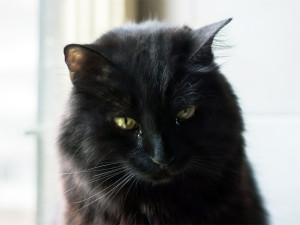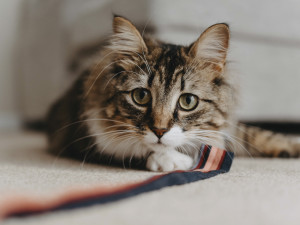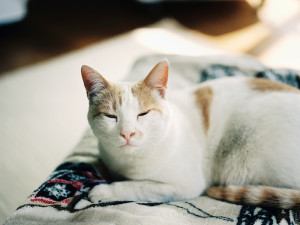Why Does My Cat Have Tear-Stained Eyes?
They can be caused by infections, excessive tears, and more.

Share Article
In This Article:
What Are Tear Stains in Cats? Why Does My Cat Have Tear Stains? Cat Epiphora When to Seek Expert Help
We love our white cats, but like a white T-shirt, they can be hard to keep clean. While your cat will do most of the cleaning work, you may notice some of them have reddish-brown streaks coming down from their eyes. Tear-staining can not only make your cat look a little sickly or unkempt but can also indicate an underlying health issue. So, what’s the deal with tear-staining in cats? Let’s find out.
What are tear stains in cats?
Like many of us, I love staring deep into a cat’s eyes. But if you notice reddish brown stains that look like tears on their face, you might have cause for concern. A cat’s eyes constantly produce tears as a way to lubricate the eyeball, flush out debris, and protect their precious vision. Under normal circumstances, those tears are drained by way of the nasolacrimal, or tear, duct that runs from the eye to the nose. When tear production is increased, it overwhelms the tear duct, allowing tears to spill over and run down your cat’s face.
But why can tears cause a brownish stain on your cat’s facial fur? Tears, along with urine and saliva, are made up mostly of water with a smattering of electrolytes and waste products. One of those waste products is porphyrin, which is an iron-containing compound that is the product of red blood cell breakdown. It’s the iron that creates the reddish-brown stain when left on fur. The lighter the fur, the easier it is to stain.

Why does my cat have tear stains?
Because tears are a normal concoction created by the eye, then tear staining should be considered a normal thing, right? Well, not exactly. All cats produce tears, but not all cats have tear stains.
Why is that? Tear staining can be the result of a number of things.
Cat breed
We may love their snub noses and constant “grumpy cat” expressions, but the facial structure of Himalayans, Persians, and other short-nosed breeds isn’t set up well for proper tear drainage. So, you may be more likely to see tear staining in these cats, especially if they have lighter-colored hair (and the same goes for our smushed-face dog breeds).
Yeast infection
A reddish-brown tint in your cat’s tear stains that looks more brown might indicate that your cat is suffering from a yeast infection and should immediately see a veterinarian.
Eye infection
On the other side of all this, there are things that can lead to increased tear product that overwhelms the ability of the tear duct to properly drain. Infections of the eyes or even the upper respiratory system, which cats are famous for getting, can make for some extra watery eyes. You may also notice some eye redness and swelling along with sneezing and nasal discharge. Tear-staining may be seen on the fur along with goopy, colored discharge from the eyes.
Blocked tear ducts
Even with normal levels of tear production, your cat could experience tear staining because they can’t properly drain the tears from their eyes. Issues with the nasolacrimal duct, such as a blockage or malformation, could lead to tear staining because the tears have nowhere else to go other than over the spillway of the eyelids and down your cat’s face.
Allergies
Similar to an infection, allergies can lead to tear-staining because the eyes ramp up tear production as a way to flush themselves of allergens. Again, there may also be some redness, sneezing, and nasal discharge. Not only can allergens, like pollen, dust, or mold, that affect the eyes cause these problems, but the irritation from food allergies may cause the problem as well.
Kitten teething
Some kittens may experience increased tear production during teething. There’s a lot of irritation going on in a kitten’s mouth as the baby teeth are switched out for their adult versions. Some of that inflammation may block the nasolacrimal duct due to their close proximity allowing tears to spill out.
Diet
Tear-staining might also be related to your cat’s diet. It’s important to offer your cat a healthy and well-balanced cat food diet, which can help clear up eye inflammation related to food allergies.
A high-salt diet can lead to hypertensive retinopathy, while a diet lacking in the nutrient taurine—which can be found in high-quality cat food and dietary supplements — will lead to severe retinal degeneration.
Other irritants
Corneal ulcers resulting from rubbing of eyelashes, hairs, foreign objects, or other injuries can also cause irritation that the eyes respond to with increased tear production. Redness, swelling, and colored discharge may be present as well. On that same note, tumors of the eyes or eyelids may result in increased tears.
Cat epiphora
Tear staining is an ugly side effect of something that may be more severe, so it’s not something that should be ignored. Changes in tear production or drainage may be the result of something going on with the eye, the tear duct, or the neighboring structures.
Any sudden changes in your cat’s tear overflow, or epiphora, should be seen by a veterinarian. Not only can epiphora mean that something more is going on with your cat, but if untreated, the excess moisture on your cat’s skin can result in infections and irritation of its own. Cat tear stains and brown eye discharge in cats can all be related to blocked tear ducts and should be checked by a veterinarian, who might have several different methods of treatmentopens in new tab.
When to seek expert help
A little discoloration on your cat’s otherwise pristine facial fur may seem like no big deal, but it’s worth having your vet take a look. Tear-staining may indicate an underlying issue that may need to be addressed.
Your vet will start the process with an exam that takes a look at your cat’s eyes and associated structures to rule out things like an eye injury, an infection, or other abnormalities that could cause irritation to the eye or tear duct. They may test the eye’s tear production, stain them to look for corneal ulcers, and test the pressures within the eyes.
Treatment for tear staining in cats
The road to a stainless face starts by treating the underlying cause, if possible. This may include flushing the tear duct or surgically repairing abnormalities of the eyelids that may lead to irritation or blockage. Infections, allergies or injuries of the eyes may be treated using medicated eye drops, while upper respiratory infections may need additional supportive care.
Tear-staining that comes by the way of facial conformation may not require treatment, but can be helped by keeping the area as clean and dry as possible. Consider carefully trimming the hair around the nose and under the eyes so that it doesn’t trap the moisture potentially leading to skin infections. You may also gently wipe the eyes with a damp cloth to remove buildup.
If you are uncertain about removing the tear stains from your cat or if you feel like the condition is serious, do not hesitate to call a vet.
References
“Corneal Ulcers.” University of Missouri Veterinary Health Center. https://vhc.missouri.edu/ophthalmology/corneal-ulcers/opens in new tab.
“Feline Ophthalmology.” University of Florida. https://smallanimal.vethospital.ufl.edu/files/2012/06/Cat-eye-problems.pdfopens in new tab.

Dr. Chyrle Bonk, DVM
Dr. Chyrle Bonk has been a mixed-animal veterinarian since 2010, with a special interest in rehabilitation. When she's not practicing or writing about veterinary medicine, you may find her exploring the outdoors with her family or tending to her cows, horses, chickens, or cats and dogs.
Related articles
![Cute striped cat pawing it's eye on the bed.]()
My Cat Has One Watery Eye and No Other Symptoms—What Does It Mean?
Here’s how to know the difference between when it’s not a big deal, and when this warrants a vet visit.
Can Cats Get Pink Eye? The Signs, Symptoms, and Treatments
The answer isn’t cute, but here’s how to help your kitty.
Can Cats Cry? How to Decipher Cat Crying
They aren’t exactly going to weep over a rom-com marathon with you, but here are the reasons your kitty could shed a tear.
![A cute cat laying on the ground with wide eyes]()
Why Do Cats Slow Blink?
Here’s what your cat’s favorite move means.
![White and light brown cat laying down with eyes almost closed]()
Study Says “Slow Blinking” at Your Cat Helps You Bond
A team of psychologists at the Universities of Sussex and Portsmouth have discovered the key to building a bond with cats.
Can You Use Neosporin on Cats? Here’s Why Not
Just because it works on humans doesn’t mean it’s good for cats.

